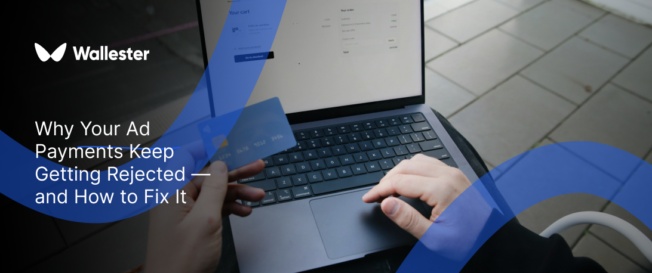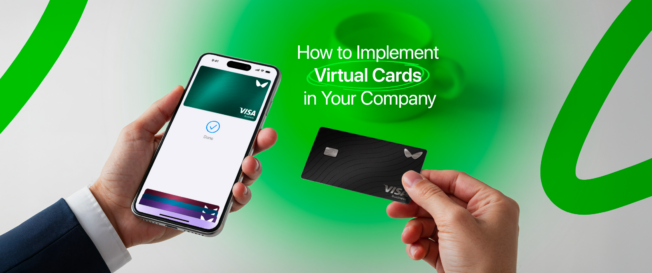Nothing disrupts a high-performing ad campaign like a failed payment. Your ads are live, traffic is flowing, conversions are coming in, and suddenly everything stops. A declined transaction can pause multiple campaigns at once, often without warning. This is a common issue for advertisers running on platforms like Google Ads, Facebook, or TikTok. It does not matter if you are spending hundreds or thousands each day. Once your payment method fails, your entire strategy is on hold until the issue is resolved.
Key Takeaways
- Most ad payment failures come down to card problems, billing mismatches, or platform triggers.
- What platforms call “suspicious activity” is often just a technical hiccup, not actual fraud.
- Suspended ad accounts can usually be recovered with a few practical steps.
- Staying ahead of payment issues is easier with the right tools and setup.
- Using Wallester virtual cards helps avoid most of these problems from the start.
Understanding Common Ad Payment Issues
Ad payment issues come in various forms, each with its own set of causes and solutions. The most frequent problems ad buyers face include declined transactions, account suspensions, and suspicious payment flags. These issues affect small startups and large corporations alike.
When your payment method fails, advertising platforms usually pause your campaigns immediately. This measure is meant to prevent unauthorised charges, but it also means your marketing efforts stop without warning. Understanding why these problems occur is the first step toward resolving them effectively.
The advertising environment has become more complex, with platforms applying stricter security checks to fight fraud. These systems protect legitimate advertisers, but they can also misidentify real transactions as suspicious. This creates an ongoing challenge: staying compliant while keeping your campaigns active and uninterrupted.
Further Reading: The Complete Guide to Payment Cards for Media Buyers
Ads Payment Failed, Why?
There are a few common reasons your ad payment might fail. Most of them are easy to overlook until your campaign suddenly stops. Here’s what to check first:
- Not enough funds. Maybe your balance dipped without you noticing, or another charge hit the account just before the ad platform tried to pull money. Even a small gap can trigger a failed payment.
- Expired card. This one happens more often than you’d think. You added the card months ago, it worked fine, and then one day it quietly expires. If you haven’t updated it, nothing gets charged.
- Mismatched billing info. If the name or address on your ad account doesn’t match what your bank has, the payment might be blocked. Something as small as a missing flat number or a misspelling can throw it off.
- Your bank is blocking the charge. Some banks treat advertising platforms as high-risk and automatically decline the payment. You might not even get a clear reason. Unless you ask, you won’t know that’s what’s happening.
These issues don’t always give you much warning. But once you know what to look for, they’re usually quick to fix.
Troubleshooting the ‘Unsuccessful Payments’ Issue
When faced with a declined payment, your first step should be to verify your account balance. Log into your bank account or contact your credit card company to confirm you have sufficient funds available. This simple check can resolve the majority of payment issues.
Next, review your payment settings within the advertising platform. Compare the billing information in your ads account with the details on your bank statement. Pay attention to:
- Your full name as it appears on the card
- The complete billing address including postcode
- The expiration date of your payment method
- The security code on the back of your card
If everything appears correct, try adding a different payment method to your account. Sometimes the issue lies with a specific card or bank rather than your account settings. Having multiple payment options also provides backup protection against future failures.
Contact your bank or credit card company if the problem persists. They can provide specific information about why transactions are being declined and may be able to authorise future payments to the advertising platform.
How to Prevent Future ‘Unsuccessful Payments’ Issues
Fixing payment issues is one thing. Avoiding them altogether is better. A few small habits can make a big difference in keeping your campaigns running without interruptions.
- Watch your balance. Check your account regularly, especially if your spend fluctuates. Set up low-balance alerts so you’re notified before things run short. This helps prevent sudden declines that pause your ads without warning.
- Keep your billing details up to date. Go through your ad platform settings at least once every few months. Make sure card numbers, expiry dates, addresses, and contact info are still accurate. Even one outdated field can block a charge.
- Use a dedicated business credit card for ad spend. These cards often come with higher limits and better fraud protection. They also make it easier to separate your advertising costs for bookkeeping, taxes, or reporting to clients.
- Have a backup plan. Don’t rely on a single card or bank. Add a secondary payment method to each platform you use. Performance marketers often rotate cards across platforms, so planning ahead prevents downtime. Switching quickly can save you from hours of downtime.
Further Reading: Top Use Cases for Virtual Cards in Business.
My Ads Have Been Suspended, Why?
Ad account suspensions can happen for several reasons, and they’re not always tied directly to payment failures. While the exact cause depends on the platform, a few common triggers show up again and again:
- Policy violations. Every advertising platform has its own set of rules about what you can promote, how you can target users, and the kind of language or imagery that’s allowed. If your ads don’t meet these standards, your account may be flagged. Even experienced media buying teams run into unexpected suspensions. Knowing the causes makes recovery faster.
- Repeated payment failures or suspicious activity. If your payment method is declined several times in a short span, or if the platform detects unusual patterns in how you pay (like sudden spikes or mismatched billing details), your account may be suspended while they investigate. This is often a fraud-prevention step.
- Verification problems. Platforms like Google Ads and Facebook Ads routinely ask advertisers to verify their identity or business details. If you haven’t completed that process or if your information doesn’t match up, they may suspend your account until the issue is resolved.
- Technical or platform errors. Sometimes the problem isn’t on your side at all. Bugs in billing systems, server outages, or miscommunication between platforms and payment providers can cause automatic suspensions, even when your account is in good standing.
Troubleshooting the ‘Ads Suspended’ Issue
When your ads are suddenly paused, the first step is to understand why. Suspensions aren’t always explained clearly, but the reason is usually somewhere in your account notifications or recent emails. Go through them carefully before taking action.
Once you have a general idea of what might have triggered the issue, check the following:
- Campaign content
Review the text, images, landing pages, and targeting. Look for anything that could violate ad policies – misleading claims, broken links, aggressive language, or sensitive topics.
- Billing details
Make sure your payment method is active, has enough funds, and matches the billing information in your account. Even a minor mismatch or a declined payment can stop all activity.
- Verification documents
If the issue is related to identity or business verification, gather all required documents. This usually includes:
- Company registration certificate
- Tax identification number
- Proof of address
- Recent bank statement
- Identity document of the account owner
- Appeal process
If you’ve reviewed everything and the suspension still doesn’t make sense, write a clear appeal. Describe what happened, mention any recent changes in your account, and attach documents that support your case. Keep your tone neutral and stick to facts. Thorough checks and a calm response often resolve these issues faster than guesswork or rushed replies.
How to Prevent Future ‘Ads Suspended’ Issues
Here are a few key habits to build:
- Set up a stable and reliable payment method. Avoid using cards that are likely to fail or expire without notice.
- Add a backup card to your account. This gives the platform another way to process payments if your primary method runs into trouble.
- Keep your business details accurate and complete. Make sure your company name, tax information, and contact details match across all documents and accounts.
- Increase your ad budget gradually. Sudden jumps in spending can trigger platform reviews, especially on new or inactive accounts.
- Monitor your account health regularly. Most platforms provide a dashboard showing alerts, policy warnings, and other indicators that can help you act before a suspension happens. Building trust with platforms helps ad buyers avoid disruptions.

Ads Suspicious Payments: What Are They?
Advertising platforms use automated systems to detect payment behaviour that might look risky. When something seems off, they often flag the payment as suspicious. This can result in declined transactions, paused campaigns, or even temporary restrictions on your ad account.
Several triggers can cause a payment to be flagged:
- Multiple failed payments in a short time, even if the cause is something simple like an expired card or low balance.
- Rapid switching between different cards or payment methods, especially without prior spending history.
- Card types or BINs (Bank Identification Numbers) that are associated with high fraud risk, often flagged by default.
- Mismatched currencies or locations, such as paying with a card issued in one country while targeting ads in another without a clear reason.
These alerts don’t always mean you’ve done something wrong, but platforms treat them seriously until they’re reviewed.
Further Reading: Virtual Card Fraud Prevention: How Secure Are They?
Troubleshooting the ‘Suspicious Payments’ Issue
When a payment gets flagged as suspicious, platforms often pause your ads while they investigate. To get your campaigns back up, you’ll need to confirm that your activity is genuine and that your payment method is trustworthy.
Here’s how to handle the issue:
- Replace the flagged card with one that has a stronger track record.
- Double-check your billing information.
- Reach out to the platform’s support or billing team.
- Be ready to verify your payment method.
- Consider lowering your ad spend during the review period.
How to Prevent Future ‘Suspicious Payments’ Issues
A few smart habits can go a long way:
- Use business-grade virtual cards that are linked directly to your company.
- Assign a separate card for each ad platform.
- Avoid mixing personal and business billing details.
- Choose a provider that supports multiple BINs.
- If you’re planning a big increase in spend, build up gradually and inform your payment provider in advance.
Media buying teams benefit from better structure and control with virtual setups.
Contacting Ads Support for Assistance
If payment problems continue, it’s time to contact support. Most platforms like Google, Meta, and TikTok offer help through live chat, email forms, or dedicated business support channels. Choose the fastest option available, especially if your ads are paused.
Before reaching out, gather the basics. Include screenshots of the error, details of the payment method used, dates, and a quick summary of what you’ve already tried. Be clear and specific. Mention the exact error message, when it appeared, and how often the issue occurred. The more precise you are, the easier it is for the support team to help.
Submit your request through official channels. Avoid sending multiple messages or switching between platforms too quickly, as this can slow things down. If you don’t hear back within a reasonable time, send a short follow-up with all the original information included.
Quick, clear requests help performance marketers get results faster.
Conclusion
Most ad payment issues aren’t caused by something you’ve done wrong. In many cases, the problem lies with outdated, unreliable, or mismatched payment methods. Platforms rely on automated checks, and even small inconsistencies can trigger declines, flags, or suspensions.
The good news is that these issues are usually easy to fix if you catch them early. Keeping your billing details accurate, monitoring your account health, and using tools built for media buying can prevent most problems before they start.
A stable setup makes a big difference. With the right payment method in place, your campaigns stay active, your budgets stay on track, and your team can focus on results, not troubleshooting.
Avoid Ad Payments Issues by Choosing Wallester’s Virtual Cards
Many advertisers run into trouble not because of what they’re doing in their campaigns, but because the payment tools they rely on aren’t made for how digital advertising actually works. Card declines, suspicious activity flags, and limited spending control can stall your campaigns when you least expect it, especially when using standard consumer cards or outdated systems.
Wallester’s virtual cards offer a purpose-built alternative. They’re tailored to the realities of online advertising and give you the flexibility, speed, and control that modern media teams need to keep campaigns running without interruption.
Here’s what you get with Wallester’s virtual card platform:
- Instant card issuance
Create and activate virtual cards immediately after onboarding. No waiting for physical delivery. Useful when launching new campaigns or replacing blocked cards.
- Campaign-specific card creation
Set up separate cards for each campaign, platform, client, or team. This keeps expenses organised and avoids internal confusion or budget drift.
- Real-time spend tracking
Monitor every transaction as it happens. You can catch unusual activity early and always know where your budget is going.
- Advanced spend controls
Set strict limits per card, restrict usage by merchant type, or define expiry rules. This setup keeps your budget in check and helps avoid transactions that might look suspicious to ad platforms.
- Multi-BIN support
Wallester supports multiple BINs (Bank Identification Numbers), allowing businesses to route payments more effectively and avoid declines from platforms with strict rules or geographic restrictions.
- Higher acceptance rates for ad platforms
Wallester virtual cards are built with digital advertising in mind. They work reliably on major platforms like Google Ads, Facebook, TikTok, and others, with fewer blocks due to technical mismatches or region-based restrictions.
- API integration
The platform connects easily with your existing systems. You can automate tasks, create cards programmatically, and bring live data into your internal dashboards.
- Security
Each card has a unique number and works independently. If something goes wrong with one card, the others stay unaffected. You can freeze or delete it instantly, without touching the rest.
Wallester also supports hybrid setups. You can use both virtual and physical cards under the same account, with shared controls and unified reporting. This gives your media buying team full flexibility online, while your operations team can keep using physical cards where needed.
For advertisers who want payment infrastructure that works as fast as they do, Wallester offers a clean and efficient way to avoid disruptions caused by tools that weren’t built for digital advertising. You stay in control and keep campaigns on track. Explore how Wallester’s virtual cards can support your campaigns and see the difference modern payment tools make.


